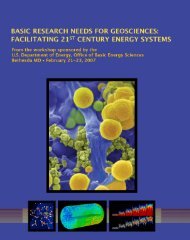Cyber Physical Systems â Situation Analysis - Energetics Meetings ...
Cyber Physical Systems â Situation Analysis - Energetics Meetings ...
Cyber Physical Systems â Situation Analysis - Energetics Meetings ...
- No tags were found...
You also want an ePaper? Increase the reach of your titles
YUMPU automatically turns print PDFs into web optimized ePapers that Google loves.
<strong>Cyber</strong> <strong>Physical</strong> <strong>Systems</strong> – <strong>Situation</strong> <strong>Analysis</strong>DRAFT – March 9, 2012performed. 232 Consumers expect wireless access to the internet when driving, flying, or riding the train.The ideal future transportation CPS would therefore allow the consumer to remain connected, while alsopersonalizing vehicles and providing comfort and convenience.Connectivity can also be applied between vehicles and infrastructure. The connectivity of vehicles toinfrastructure could greatly reduce traffic, which would reduce emissions and make commutes moreconvenient and efficient for travelers. Vehicle-to-vehicle (V2V) and vehicle-to-infrastructure (V2I)systems are applications that demonstrate the potential of CPS in transportation. By connecting vehicleswith other vehicles as well as with the transportation infrastructure, there is potential for lower accidentrates and a major market for electronics suppliers and software companies. It is likely that almost everypassenger vehicle sold in 2020 will have V2V systems and that these systems will ultimately lead toautonomous driving. Although the connected car is just emerging, future possible communication linkscould enable innovation in applications and services that will benefit drivers, passengers, automotivemanufacturers, and society in general. 233AutonomyRecent reports indicate that the trend toward autonomy is growing in all transportation sectors. 234 Theevolution of autonomous transportation systems promises to save lives, increase throughput, and evenreduce fuels costs. Whether this takes the form of a self-parking or self-driving vehicle, or a militaryaircraft automatically completing a mission, the future vision of autonomy can potentially improve safety,efficiency, security, and convenience. An example is automated parking assistance, which is alreadyavailable in many new model vehicles. Unmanned aerial vehicles (UAVs) are already used in militaryoperations in Iraq and Afghanistan and have been used in civilian airspace to collect data.CURRENT STATE OF THE TECHNOLOGYDecision makers, industry officials, and experts in the United States agree that intelligent transportationsystems and connected vehicle technologies are the future of travel, and will improve safety, efficiency,and the economy. 235 Today, humans play an active role in both automotive and aviation operations.People drive vehicles while sensor systems alert the driver to various dangerous situations (lane changes,crash ahead). Although modern aircraft have a larger amount of automation, pilots still play an essentialrole in control and UAVs have yet to make a significant presence in NAS. However, CPS are increasinglybeing applied to make it easier, safer, and more convenient for humans to operate and use transportationsystems.Connected Vehicle TechnologiesThe main focus in ITS research that is particularly related to CPS is connected vehicle technologies,specifically V2V and V2I communications. Examples of V2V applications in vehicles include blindspot/lane change warnings, forward collision warnings, electronic emergency brake lights, intersectionmovement assistance, do not pass warnings, and control loss warning. Examples of V2I applications232 Juliussen and Robinson. ―Is Europe in the Driver‘s Seat?‖233 Juliussen and Robinson. ―Is Europe in the Driver‘s Seat?‖234 Poovendran et al. ―2008 HCTCPS Workshop Report.‖235 18 th World Congress on Intelligent Transport <strong>Systems</strong>. ―America‘s Transportation Leaders Agree that IntelligentTransportation is the Future of Travel.‖ 21 Oct 2011.44
















